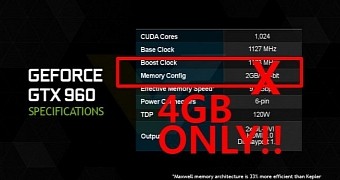It seems that the initial batch of NVIDIA GTX 960 graphics cards will be withdrawn from retailers' shelves by the graphics adapter giant. Coming at around $200, it's cheaper than the GTX 760, and although it has a limited 128-bit bus, it may retain only the 4GB version to make it attractive to potential buyers.
Currently coming with two flavors of memory sizes, the 4GB GDDR5 and 2GB GDDR5, the NVIDIA’s GeForce GTX 960 was the first to feature the GM206 graphics processing unit, and features 1024 CUDA cores, 64 Texture mapping units and 32 Raster operation units.
It is clocked at 1127 MHz base and 1178 MHz boost clock. The video memory works at 7.00 GHz (1753 MHz QDR), dishing out 112 GB/s of cumulative bandwidth.
However, according to a report coming from HWBattle.com, it seems that NVIDIA decided to withdraw the card from retailers since customers will always be able to spend an extra buck to buy a card with double the memory size for nowadays games.
Originally built to fight against the AMD Radeon R9 280 that came with a much bigger 384-bit bus and with 3GB of vRAM, it could deal much better at rendering large distances in games while also allowing a bigger bandwidth when rendering shaders.
Despite still being powerful, NVIDIA looks at statistics and decides to cancel the 2GB model
Now that AMD has refreshed its line of graphics cards, and brought the new "Tonga" Radeon R9 380, a card that is currently cheaper and definitely a bit more powerful, NVIDIA decided to stop the production of the GTX 960 2GB version since it can't properly compete against the AMD rival in that segment.
However, this decision is probably made at face value. The card's GPU, the GM206 is an excellent overclocker, and with some proper tweaks it can reach core frequencies much higher than the R9 380, while nowadays vRAM memory is usually shared with DRAM modules via PCI-E in real time so memory size tends to become obsolete.
However, statistics show that it doesn't sell that well since not all NVIDIA customers overclock their cards to the extreme, or know how to do it, so it makes sense for some to buy the more expensive card.

 14 DAY TRIAL //
14 DAY TRIAL //